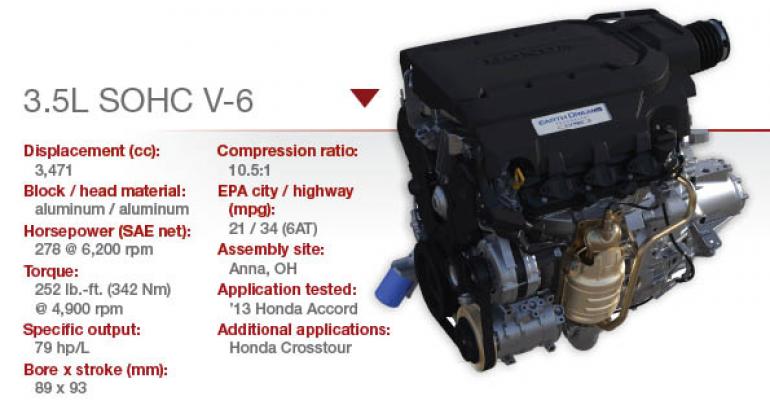A funny thing happened while Ward’s 10 Best Engines judges drove 590 miles (950 km) in the all-new ’13 Honda Accord Touring sedan: Without even trying, seven editors – most of them with lead in their boots – overshot the window-sticker combined fuel-economy rating of 25 mpg (9.4 L/100 km) by a wide margin.
That’s what the Environmental Protection Agency says most drivers should achieve in city/highway motoring with the extensively reworked 3.5L SOHC V-6.
The WardsAuto team of hyper-miler flunkies averaged 29.4 mpg (7.9 L/100 km) in early November – outstanding for an engine this size – while editor Christie Schweinsberg set the high bar at 31.1 mpg (7.5 L/100 km) after a weekend road trip to northern Michigan.
 “I saw 35.5 mpg (6.6 L/100 km) on the trip computer after the first 100 miles (160 km) on the freeway,” Schweinsberg reports. Factor out the 258 miles (415 km) she logged, and the combined mileage still exceeds 29 mpg.
“I saw 35.5 mpg (6.6 L/100 km) on the trip computer after the first 100 miles (160 km) on the freeway,” Schweinsberg reports. Factor out the 258 miles (415 km) she logged, and the combined mileage still exceeds 29 mpg.
Now, aren’t consumers complaining a lot of vehicles deliver disappointing real-world fuel economy, which suggests the EPA test cycle represents something other than the real world? Oh, the folks at Hyundai must be eating their hearts out.
For delivering exemplary fuel economy and simultaneously pulling like a freight train at hard throttle, Honda’s improved 3.5L V-6 earns its fourth Ward’s 10 Best Engines trophy since 2005.
We’ve always cherished this 60-degree titan as an unsung hero whose power easily surpasses the numbers on the spec sheet.
The latest iteration comes with several significant updates and makes a convincing argument that modern engines do not need direct fuel injection to achieve benchmark performance. Besides, port-injection engines such as Honda’s V-6, as well as Chrysler’s 3.6L Pentastar, are less expensive to build.
Honda has an edge with a new cylinder-deactivation system that saves more fuel than on the previous-generation engine. The Variable Cylinder Management system used to shut down two or three cylinders at a time, depending on driving load. Now, it only switches to 3-cyl. mode.
When maximum power is required, all six cylinders are firing, and transitions between the two modes are seamless. Enabling VCM to work more often is a new, more-robust 28-volt active engine mount system that minimizes engine vibration during the transitions. An active noise-control system cancels any other undue sounds within the interior. VCM is available only with the 6-speed automatic transmission.
For the first time, this new Accord application combines VCM with Honda’s heralded Variable Valve Timing and Lift Electronic Control (VTEC) system, which changes valve lift, timing and duration of the intake valves to deliver more torque earlier in the powerband.
Separate from VCM, the system is intelligent enough to vary valve operation based on the driving situation and engine speed. At low rpm, VTEC optimizes intake valve timing and lift for increased torque.
As the tachometer needle passes 5,150 rpm, VTEC transitions to a high-lift, long-duration intake-cam profile for superior power at high-rpm. With the manual transmission, this transition happens even earlier, at 4,900 rpm.
Each low-pressure cast-aluminum cylinder head incorporates a new “tumble port” design that enhances combustion efficiency, and an integrated exhaust manifold within each head requires fewer parts, improves flow and allows for closer coupling of the catalytic converter downstream, which reduces emissions.
Put all this technology together, and this new silky-smooth “Earth Dreams” V-6 positively storms. “It’s never lacking for acceleration,” writes WardsAuto editor Byron Pope.




